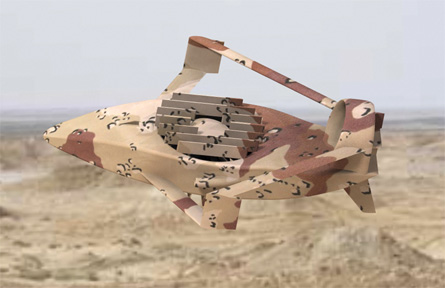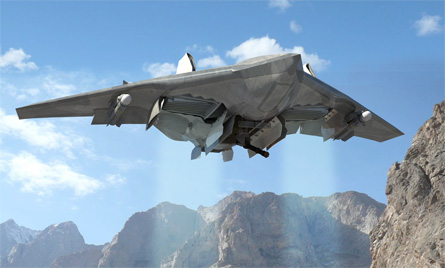Long-discarded ideas in aviation may fade, but never seem to die. Recycling good-but-not-quite-adequate design ideas occurs in every major evolution of aviation technology, and is happening again with the rise of unmanned air vehicles.
Nowhere is this phenomenon more apparent than the perpetual search to solve one of the oldest puzzles of powered flight: how to take off and land vertically without unduly compromising payload, speed or range?
Walking the exhibit hall at the Association for Unmanned Vehicle Systems International (AUVSI) annual convention in Denver from 24-27 August afforded glimpses of nearly forgotten ideas for accomplishing vertical take-off and landing (VTOL) capability.
In booth 2414 stood a revival of the core technology of the Bell X-22A, a 1960s-era experiment using with four tilting, ducted fans.
 |
|---|
© American Dynamics |
Maryland-based start-up American Dynamics calls its tilting ducted-fan vehicle the AD-150, an aircraft in the same weight class as the General Atomics Predator A. Using American Dynamics' high torque aerial lift technology, the AD-150 is designed to fly at 300kt (555km/h) carrying a 226-453kg (500-1,000lb) payload.
The US Marine Corps is rethinking whether it wants an unmanned VTOL aircraft, a requirement the AD-150 was conceived to provide. But the US Navy may be looking for a similar capability to move cargo on to ships, says American Dynamics founder Wayne Morse.
With funding provided by the Maryland state government and Naval Air Systems Command, American Dynamics has completed windtunnel tests of subscale and full-scale models. A powered model will be tested in the windtunnel from October to November, Morse says.
More unconventional was the V-STAR mock-up designed by Colorado-based Frontline Aerospace displayed in booth 1435.
 |
|---|
© Frontline Aerospace |
Sized at full-scale in the same category as the AD-150, the V-STAR would be powered by two Rolls-Royce Model 250 engines. The engines drive one ducted fan in the centre of the V-shaped fuselage for vertical lift and an aft-mounted ducted fan for horizontal thrust. A diamond box wing is incorporated to provide lift without interfering with the ducted fan installed inside the fuselage.
Frontline's V-STAR is designed for the emerging requirement for an autonomous resupply capability, says company founder Ryan Wood. The company has flown a quarter-scale model, but further tests depend on funding, he says.
The autonomous resupply mission is driving both small and large companies to look for new ways to deliver VTOL capability. As the navy considers its requirements, early interest is focusing on new unmanned systems that provide dramatically more endurance without sacrificing payload.
In response, Northrop Grumman and Lockheed Martin have been working radical designs also on display at AUVSI. The fan-in-wing technology pioneered by the Ryan XV-5 vertiplane appears to have been revived in Northrop's multipurpose unmanned VTOL resource, or MUVR, and Lockheed's VTOL advanced reconnaissance insertion organic unmanned system (below).
 |
|---|
© Lockheed Martin |
Not surprisingly, however, small companies are making steady inroads against the larger companies with new designs for UAVs.
Another example was on display at booth 4008. California-based MLB showed the V-bat family of UAVs, including a VTOL version. MLB's design recycles another discarded experiment from the 1950s - the tail-sitter.
 |
|---|
© MLB |
Neither the Convair XFY-1 or Lockheed XFV-1 were deemed practical for a pilot to land. But the unmanned V-Bat VTOL design faces no such limitation.
The 31kg V-Bat is being used by the Defense Advanced Research Projects Agency to demonstrate the ability of covertly placing small weapons or sensors on the ground deep inside enemy territory.
For more coverage from the AUVSI convention, visit our dedicated show site
Source: Flight International























